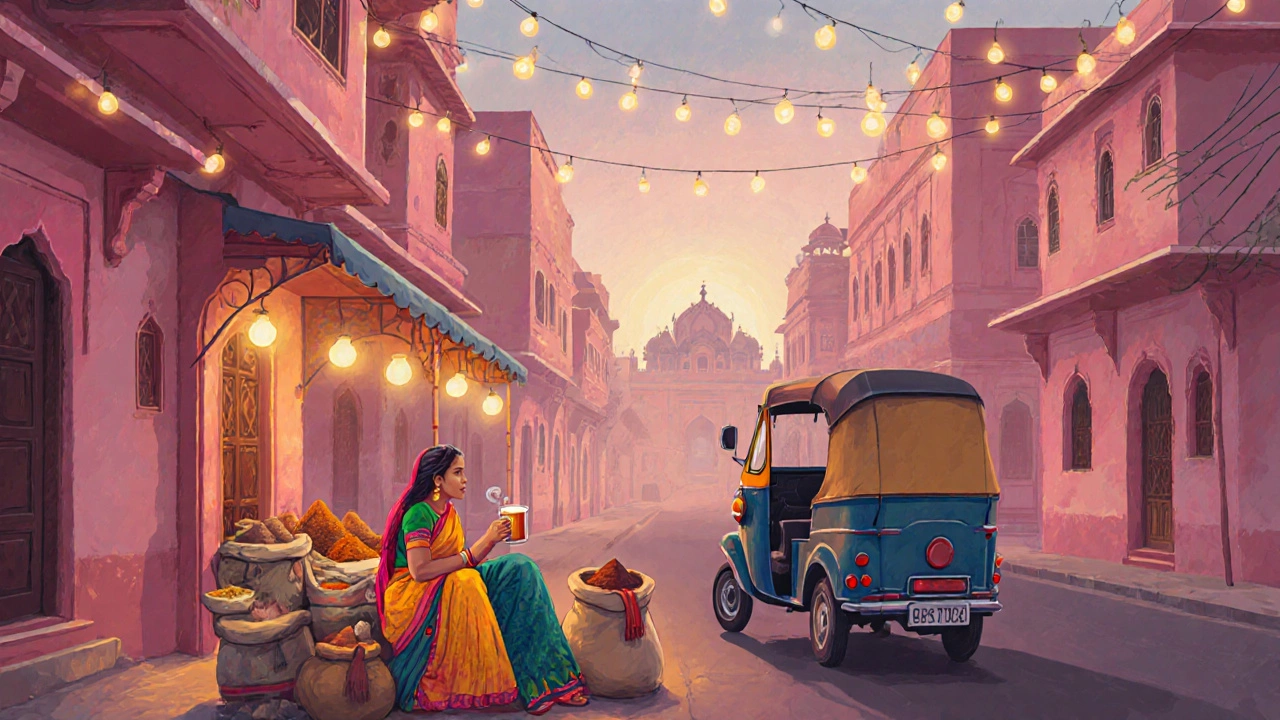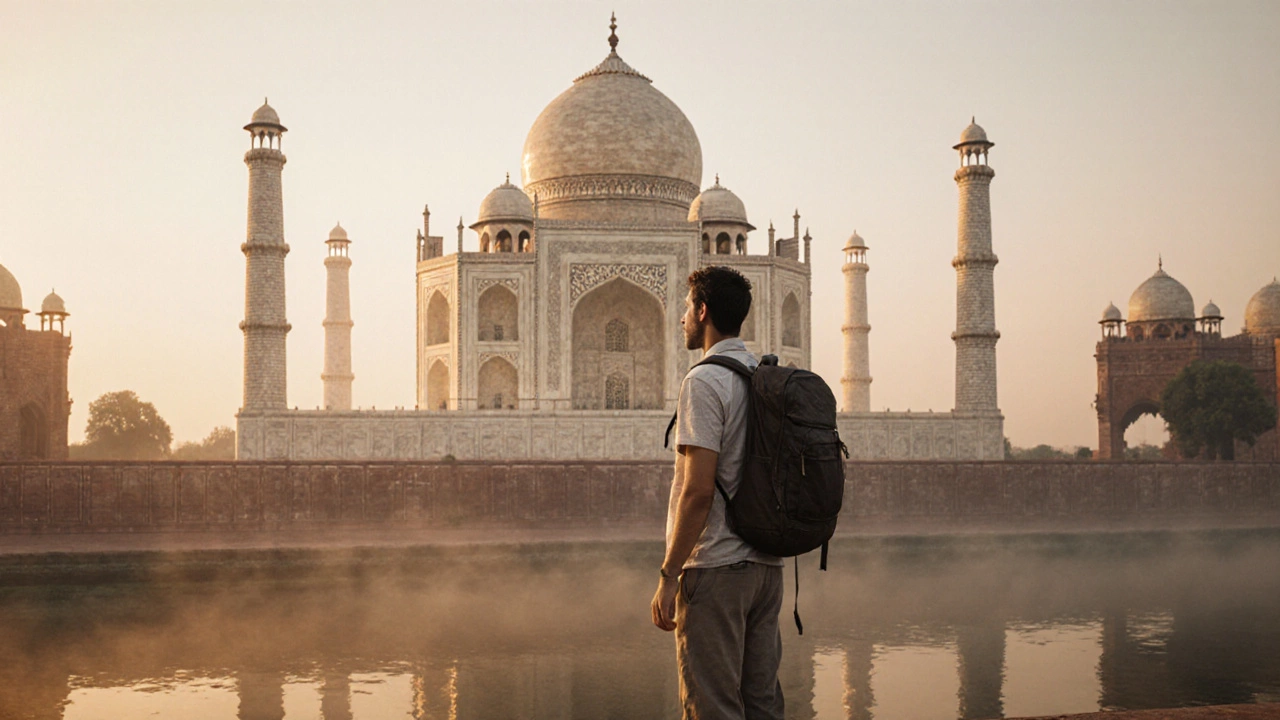India Budget Calculator
How much will your India trip cost?
Calculate your realistic budget for a 2-3 day trip based on your destination, transport, and accommodation choices.
Your estimated trip cost
Total budget:
Based on your selections and realistic pricing for short trips
Cost breakdown
Transport:
Accommodation:
Entry fees:
Food & drinks:
Local transport:
SIM card:
Miscellaneous:
Tip: Staying within walking distance of main attractions can save ₹300-500 on local transport.
Select your trip parameters to see your budget estimate. Based on data from the article.
If you’ve ever looked at your calendar and thought, ‘I only have three days off-can I even go to India?’-the answer is yes. You don’t need a week off, a big budget, or a visa waiver to have a real India experience. In fact, many travelers find their first taste of India in just two or three days. The minimum vacation in India isn’t about how long you stay-it’s about how smart you pick your spot.
Two Days Is Enough If You Pick Right
Two days in India isn’t a joke. It’s what thousands of business travelers and weekend explorers do every week. Take Jaipur, for example. Arrive at the airport by noon on Friday, check into a heritage guesthouse in the Pink City, and by sunset you’re sipping masala chai at Jantar Mantar while watching the sun paint the Amber Fort orange. Saturday morning: Albert Hall Museum, then lunch at Laxmi Misthan Bhandar. By 3 p.m., you’re on a train back to Delhi. You’ve seen forts, tasted street food, and walked through living history. No tour guide needed. Just a map, a phone, and curiosity.
Same goes for Hampi. Fly into Bengaluru, take a 5-hour train to Hospet, rent a bicycle, and spend Saturday cycling past stone temples, boulder piles, and riverside cafes. Sunday morning: breakfast at a local homestay, then head back. You’ve seen ruins older than Rome, eaten fresh jackfruit, and slept under stars without spending more than ₹3,500 ($42 USD).
What You Can Actually Do in 48 Hours
Let’s break down what’s realistic in two full days:
- Arrive by noon - Book a flight that lands before 2 p.m. to maximize your first day.
- Stay near the main attraction - Pick accommodation within walking distance of your main site. In Agra, stay near the Taj Mahal gates. In Varanasi, pick a guesthouse on the ghats.
- Focus on one city or zone - Don’t try to do Delhi and Agra in two days. Pick one. Agra alone has the Taj, Agra Fort, and Fatehpur Sikri. You can hit two of those.
- Use local transport - Auto-rickshaws cost ₹50-100 for short rides. Trains between nearby cities are ₹200-400 and take under 4 hours.
- Eat local - Street food isn’t risky if you pick busy stalls. Try pani puri, vada pav, or chaat. Avoid raw salads and unpeeled fruit.
One traveler from London did this exact trip: flew into Delhi on Friday evening, took the overnight train to Agra (₹380, 4th AC), woke up at 5 a.m., saw the Taj at sunrise (entry ₹50 for Indians, ₹1,100 for foreigners), had breakfast at a roadside dhaba, took the 10 a.m. train back to Delhi, and flew home Sunday evening. Total spend: ₹8,200 ($98 USD). That’s less than a weekend in London.
Where to Go for the Shortest, Best Trip
Not all Indian cities work for a two-day trip. Here are the top five that do:
- Agra - The Taj Mahal alone justifies the trip. Add Agra Fort and a quick stop at Mehtab Bagh for sunset views.
- Jaipur - Pink City vibes, Hawa Mahal, City Palace, and a spice market. Easy to navigate on foot or by auto.
- Varanasi - Ganga aarti at Dashashwamedh Ghat at dusk. Walk the narrow alleys. Eat kachori at Thatheri Bazaar. No need to stay more than one night.
- Hampi - Ancient ruins, boulders, and riverside cafes. Only 5 hours from Bengaluru. Perfect for nature lovers.
- Goa (North) - Baga Beach, Anjuna Flea Market, and a seafood dinner by the water. Skip the clubs. Stay in a simple guesthouse.
These places have reliable trains, affordable stays, and clear paths for solo travelers. You won’t need a tour operator. Just your phone, a power bank, and a sense of direction.

How Much Does It Really Cost?
Here’s a real breakdown for a two-day, one-night trip to Agra:
| Item | Cost (₹) | Cost (USD) |
|---|---|---|
| Delhi-Agra train (4th AC, round trip) | ₹760 | $9 |
| Guesthouse (basic room, 1 night) | ₹1,200 | $14 |
| Taj Mahal entry (foreigner) | ₹1,100 | $13 |
| Agra Fort entry | ₹400 | $5 |
| Food & drinks (street + 1 meal) | ₹800 | $10 |
| Auto-rickshaw rides (3 trips) | ₹300 | $4 |
| Local SIM card (2GB data) | ₹200 | $2 |
| Total | ₹4,760 | $57 |
That’s under $60 for a full cultural experience. Compare that to a weekend in Paris or Rome. India’s affordability isn’t a myth-it’s math.
What Not to Do on a Short Trip
People make the same mistakes over and over:
- Trying to see too much - Don’t try to do the Taj, Agra Fort, Fatehpur Sikri, and a cooking class in 48 hours. Pick two.
- Booking hotels far from the center - A hotel 10 km from the Taj means two auto rides per day. That’s ₹400 wasted.
- Waiting until the last minute to book trains - IRCTC fills up fast. Book at least 3 days ahead.
- Expecting Wi-Fi everywhere - Many heritage sites have no signal. Download offline maps and save photos before you go.
- Thinking you need a guide - Most sites have free audio guides on your phone. Or just walk slowly and read the signs.

Why This Works Better Than a Longer Trip
Longer trips often mean exhaustion. You spend half your time on trains, waiting in lines, or trying to fit in ‘everything.’ A short trip forces you to slow down. You notice the way the light hits the Taj at sunrise. You taste the difference between street chai and hotel chai. You talk to the shopkeeper who gives you extra pani puri because you smiled.
One woman from Sydney told me she went to India for three days because she couldn’t take more time off work. She didn’t see the Himalayas. Didn’t go to Kerala. But she sat on the steps of the Taj at dawn, ate a samosa with her fingers, and cried-not from sadness, but from the quiet beauty of it all. That’s the India you remember.
Final Tip: Start Small, Then Come Back
India isn’t a place you conquer. It’s a place you return to. Your first trip doesn’t need to be epic. It just needs to be real. Two days is enough to fall in love with the chaos, the colors, the smells, the noise, and the kindness. And once you’ve had that taste, you’ll be back. Maybe next time with a week. Or a month. But you’ll come back.
For now? Pack light. Book your train. Show up. And let India surprise you in less than 48 hours.
Can I visit India with only two days off?
Yes. Many travelers do it. Focus on one city like Agra, Jaipur, or Varanasi. Book a train or flight that lands early and leaves late. Stay close to your main attraction. You’ll get more out of two focused days than seven scattered ones.
What’s the cheapest way to get to India for a short trip?
Fly into Delhi or Bengaluru, then take a train to your destination. Trains are far cheaper than domestic flights. A 4th AC ticket from Delhi to Agra costs under ₹400 one way. Use IRCTC’s website or app to book. Avoid last-minute bookings.
Is it safe to travel alone in India for two days?
Yes, if you’re smart. Stick to well-known tourist spots. Avoid walking alone at night. Use trusted auto-rickshaws with meters or apps like Ola. Women travelers should dress modestly and avoid isolated areas. Most locals are helpful. Carry a local SIM card for maps and emergencies.
Do I need a visa for a short trip to India?
Most foreign travelers need an e-Visa, which takes 3-5 days to process and costs $80 USD. Apply online at the official Indian government portal. It’s valid for 60 days and allows two entries. Don’t wait until the last minute-apply at least a week before you fly.
What should I pack for a two-day trip to India?
Lightweight, breathable clothes. A scarf for temple visits. Comfortable walking shoes. A small power bank. A reusable water bottle. Hand sanitizer. A basic first-aid kit. Don’t overpack. You’ll buy snacks, souvenirs, and tea along the way.
